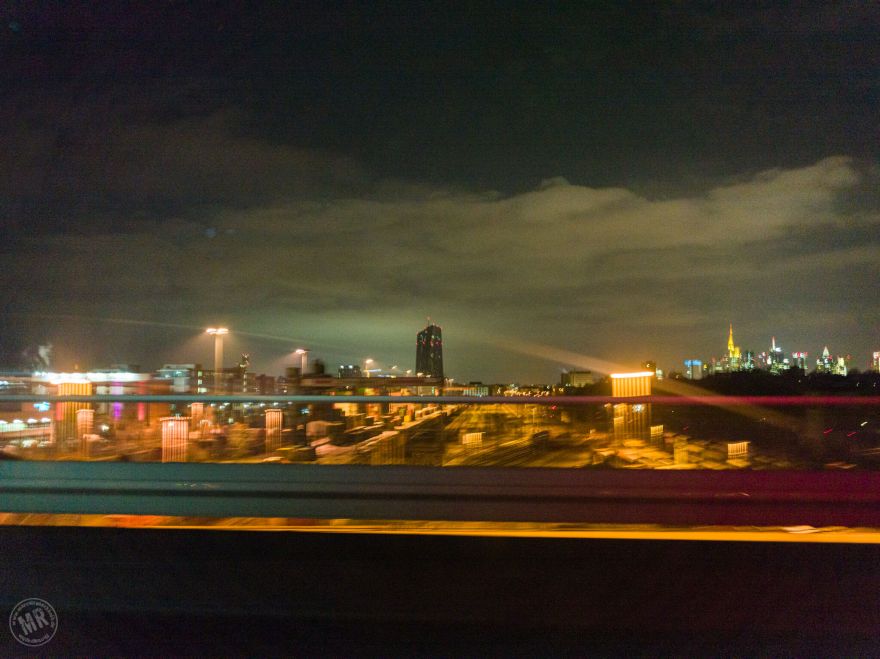PHO702 Week 4, Reflection

This weeks’ theme revolved around the different meanings of an image and how they arise.
In “Image, Music, Text”, Roland Barthes notes, that “It is necessary to overthrow the myth, the birth of the Reader must be at the cost of the death of the Author” (Barthes and Heath 1987, 148). His idea is that too much importance is attached to the author; the meaning is generated by the reader alone. With this in mind, we had had to post a (new) picture our peers hadn’t seen before; without any additional explanation.
I choose an image I took four weeks ago. It shows Frankfurt at night, seen from the east. My peers commented it in these ways:
A: “This image for me depicts a sense of loneliness or melancholy, by the lack of visible humans it feels isolated, divided from the rest of the city via the railings. Yet, there is also a sense of feeling overwhelmed by the hectic business, as shown via the blur of living in a city.”
B: “The city as energy and motion. The enthralling nature of night time in a city as perhaps one passes by as part of a journey. I feel that I am definitely there in the moment of capture thanks to the blur. But I also don’t know which city it is and whether we will be stopping at all. Then the colours give a sense of transience, of time passing, and that parts of this place are not permanent, they are fragments of time or things I thought I saw in passing but were never really there.”
C: “A sudden glimpse to the left or right, and this moment is seen. A journey through as you move from A to B. Heading into the city or away.”
D: “A lot of motion, warm light. Leaving the city, transition. It has a feel of a road movie.”
In each of them, I see a part of my intention(s). It’s true that Frankfurt is hectic and dominated by business, especially finance. Then there is the movement; the journey we made while I shot the image. And with this short piece of time, that is captured in the image – when I looked at the display of the camera, the moment was gone for seconds.

One aspect of my intention wasn’t there. It is the big black building in the middle, the European Central Bank. That is understandable because I can’t expect that my peers, who aren’t locals, know either Frankfurt or the ECB building. This building always reminds me of a sci-fi movie, where some threatening space ship falls on earth. Its architecture symbolizes, in my eyes, power, financial and political. Even in this image, it tries to dominate the cityscape. But these thoughts were perhaps transportable only with additional titling or a caption.
I close with the experiment I gave notice of in the headline. This image, plus the three others posted here, are part of it. I experiment with the different types of speed that interact in pictures like this: The cars velocity, the cameras shutter speed, film speed, and if it is also moving, the objects speed. The results are not predictable, perhaps a little bit with more routine. In contrast to my other work, where I can anticipate a lot more, this is a direction I will investigate in the next time. It is a follow-up of the “One-Minute exposures” I did in the last module.
The enemy of photography is the convention, the fixed rules of “how to do”. The salvation of photography comes from the experiment.
(‘Laszlo Moholy-Nagy – Artist Quotes / Atget Photography.Com / Videos & Books’ 2020)
References:
BARTHES, Roland and Stephen HEATH. 1987. Image, Music, Text. London: Fontana Press.
Peers quotes from the forum “Viewers Make Meaning”, Falmouth University
‘Laszlo Moholy-Nagy – Artist Quotes / Atget Photography.Com / Videos & Books’. 2020. [online]. Available at: https://www.atgetphotography.com/Selection/moholy-nagy.html [accessed 27 Jan 2020].




You must be logged in to post a comment.